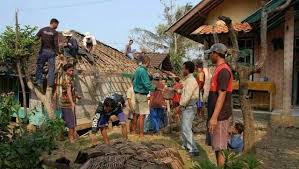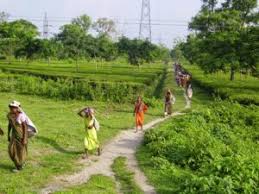This article focuses on social processes in rural society. The major basic social processes covered include: competition, conflict, cooperation, accommodation, assimilation, and acculturation. After studying this article, the expected objectives are listed below.
Definition and Meaning of Social Processes in Agriculture
Interaction among members of a society occurs within its structure through specific forms, referred to as social processes. Social interaction is “society in action” and has been defined as the “dynamic interplay of forces in which contact between persons and groups results in a modification of the attitude and behaviour of the participants” (Sutherland, 1961).
Social interaction that assumes a repetitive pattern in a specific direction becomes a social process. Social processes, therefore, refer to “repetitive forms of behaviour which are commonly found in social life”.
People’s interactions in rural areas occur through dynamic processes. For instance, rural dwellers often join hands to complete tasks such as digging a communal water source through cooperation.
A few community members who are deprived of their usual source of water for farm irrigation may disagree with the proposal. Their resistance can lead to open hostility or conflict.
Farmers who succeed in growing dry season vegetables using other sources of irrigation water might attract the same group of customers, resulting in competition.
When different cultures coexist in society through mutual adoption, it reflects accommodation. One culture may absorb the other through assimilation. When two cultures blend, the process involved is acculturation. Understanding how these and other rural social processes operate is essential for the student of rural society.
Read Also: Most Beautiful Flowers: All You Need To Know About
Understanding Competition as a Social Process in Rural Areas

Opposition and cooperation are two important social processes. Opposition is the struggle of one against another to achieve a valuable outcome, while cooperation is the unification of efforts to attain a goal. Two forms of opposition are distinguishable: competition and conflict. Their differences include:
1. Competition is continuous and occurs in all settings; conflict is intermittent and arises during crises.
2. Competition involves no personal contact or attack; conflict often involves both.
3. Competition is often unconscious; conflict is conscious.
4. Competition does not necessarily harm the opponent or alter status; conflict may do both.
5. Competition proceeds in an orderly way; conflict is often disorderly.
Competition is a form of social interaction in which two or more individuals or groups strive against each other for possession or use of material or non-material goods. The focus is on the desired objective, and less on the rivals. If the goal is scarce or limited to one party, competition becomes more intense.
According to Horton (1964), competition is the struggle for possession of items in limited supply, defined as “the process of seeking to monopolize a reward by surpassing all rivals”.
Competition exists among plants and animals in nature. The idea of “survival of the fittest” is based on competition for limited resources. These resources may be material (money, land, houses) or non-material (status, prestige, political offices).
Forms of Competition in Rural Settings
1. Absolute and Relative Competition: Absolute competition exists when only one competitor can secure the goal, e.g., only one person wins an election. Relative competition allows several people to achieve varying degrees of success, such as competing for wealth or status.
2. Personal and Impersonal Competition:In personal competition, attention is on the rival as well as the goal, and it may verge on conflict. Impersonal competition focuses only on achieving the goal, not on defeating others. For example, in labour-management disputes, both sides seek favourable outcomes without personal rivalry.
Functions of Competition in Agricultural Communities
1. It is one method of allocating limited resources, alongside urgency-based distribution or rationing.
2. It shapes competitor attitudes, often leading to unfriendly relations.
3. It stimulates individuals and groups to perform better, and in agriculture, it can raise productivity if supported by culture.
Limitations of Competition in Rural Society
1. Some individuals may avoid competition by using work quotas or promotion through seniority to escape the stress and insecurity of competition.
2. Those frequently defeated may withdraw, while regular winners may be encouraged.
3. Competition mostly stimulates performance in tasks that are routine and where output quantity matters.
Read Also: Bouqs Flowers: All You Need To Know About
Understanding Conflict as a Rural Social Process

Conflict is a struggle in which parties attempting to reach a goal strive to weaken or eliminate the opponent. Victory is achieved at the opponent’s expense. Horton (1964) defined conflict as “the process of seeking to monopolise rewards by eliminating or weakening competitors”.
Types of Conflict in Rural Communities
- Pastoral-agricultural conflict
- Town-country conflict
- Class struggle
- Inter-family and inter-clan conflict
- Conflict over wages
- Conflict over land
- Person-to-person conflict
The key difference between competition and conflict lies in their focus and methods. In competition, the focus is the goal, and behaviour follows cultural rules. In conflict, the goal is achieved by incapacitating the opponent.
Characteristics of Conflict in Rural Society
1. Conflict may be individual or group-based.
2. Conflict becomes intense when close relationships are involved.
3. Conflict is cumulative; each aggressive act encourages retaliation.
4. Previously conflicting groups may unite for a shared purpose.
5. Conflict sources may be hard to identify.
6. Some societies provide outlets for aggression, such as festivals.
7. Conflict arises from opposing interests.
8. Conflict is a temporary interaction that often leads to accommodation.
9. Conflict can have both disintegrative and integrative outcomes.
10. The hostile phase of conflict is temporary and usually ends with accommodation or assimilation.
Social Processes in Rural Society
A. Cooperation
Cooperation means working together toward common goals. The term comes from two Latin words: “Co” meaning together, and “operate” meaning to work. Therefore, when two or more individuals or groups work or act jointly to achieve a shared objective, it is called cooperation.
Several factors may motivate cooperation, and such situations may bring it about. These include:
1. Personal gain: Individuals may cooperate when it benefits them personally.
2. Common motives: Shared interests or desires encourage people to work together.
3. Situational necessity: Sometimes cooperation is required to overcome shared challenges.
4. Achievement of goals of greater value: Cooperation enables the attainment of goals that are more valuable when achieved together.
Forms of Cooperation
Cooperation can take various forms, including:
1. Loyalty-based cooperation: Occurs when people share allegiance to the same goal.
2. Antagonistic cooperation: Seen in labour disputes where opposing sides negotiate.
3. Mutual dependence cooperation: Arises when groups rely on one another.
4. Competitive cooperation: Occurs when individuals or groups work together to outdo others.
5. Enforced cooperation: Happens under authority or control due to subordination.
Types of Cooperation
1. Primary Cooperation: Found in close-knit groups where group life absorbs individual life, e.g., in a monastery.
2. Secondary Cooperation: Common in formal institutions like businesses or factories; it is limited and specialized.
3. Tertiary Cooperation: Unstable cooperation between conflicting groups for a temporary common goal, e.g., political alliances.
Regardless of its form, cooperation is always goal-oriented and remains one of the most continuous and universal social processes, often influencing individuals without their awareness.
B. Accommodation
Accommodation refers to the adjustment of individuals or groups to resolve conflict or threat, leading to the recognition and acceptance of relationships within a group or larger social system. Horton (1964) defines accommodation as “a process of developing temporary working agreements between conflicting individuals or groups.”
This process can occur when rival groups create alternatives to conflict to end hostilities and allow cooperation.
Forms of Accommodation
1. Compromise: Each party makes concessions until a mutually acceptable agreement is reached.
2. Conversion: One party adopts the views or beliefs of the other, often related to religion.
3. Tolerance: Parties agree to disagree, respecting each other’s opposing viewpoints.
4. Arbitration: A neutral third party helps settle disputes either formally (courts) or informally.
5. Truce: A temporary halt to conflict, allowing parties to reflect and consider resolutions.
6. Subordination and Superordination: Structured relationships between victors and the conquered, often temporary.
7. Displacement: Redirecting conflict by blaming others, such as minorities or external forces.
8. Institutionalized safety valves: Events like festivals or sports that allow the release of social tensions.
Accommodation is both a process and a result of social interaction, often emerging from conflict or competition to support social stability.
3. Assimilation
Assimilation is a social process through which cultural differences fade and individuals or groups that were once dissimilar become culturally similar. It has been defined as “a process of mutual cultural diffusion through which persons and groups become culturally alike” (Horton, 1964).
Assimilation often occurs when a minority group gradually adopts the dominant culture, such as immigrants adjusting to the host country’s lifestyle.
Retarding Factors of Assimilation
1. Extreme cultural differences: Lack of shared elements between cultures slows assimilation.
2. Prejudice: Stereotyping and ethnocentrism hinder acceptance.
3. Physical differences: Visible traits that lead to discrimination can delay assimilation.
Conducive Factors of Assimilation
Assimilation is encouraged when the above barriers are absent and individuals participate freely in shared social and cultural activities (Sutherland, 1961).
Forms of Assimilation
1. Cultural relocation: A person raised in one culture moves and blends into another over time.
2. Cultural merging: Two distinct cultures combine to form a new, mixed culture.
3. Family assimilation: In small groups such as families, members begin to adopt similar behaviors, like between spouses.
Assimilation leads to greater unity in society by reducing cultural differences through shared experiences and interactions.
D. Acculturation
Acculturation is the process of cultural change resulting from continuous contact between different cultures. It involves acquiring and using new cultural traits in daily life.
While assimilation involves the complete merging of cultures, acculturation refers to the earlier stage where individuals or groups begin to adopt elements of another culture. It does not necessarily lead to full assimilation and can occur even during conflict.
Acculturation affects changes in behavior, including knowledge, attitudes, and skills. Unlike assimilation, it does not include biological mixing and may not always result in mutual acceptance.
A key example of acculturation in agriculture is the introduction of hybrid maize into Nigeria by the International Institute of Tropical Agriculture (IITA). The advanced cultivation techniques required for this maize are influencing traditional farming systems, demonstrating cultural blending in agricultural practices.
Do you have any questions, suggestions, or contributions? If so, please feel free to use the comment box below to share your thoughts. We also encourage you to kindly share this information with others who might benefit from it. Since we can’t reach everyone at once, we truly appreciate your help in spreading the word. Thank you so much for your support and for sharing!

